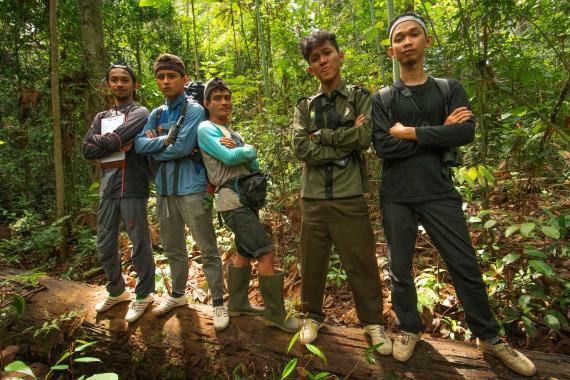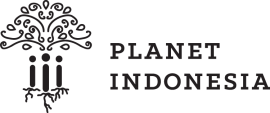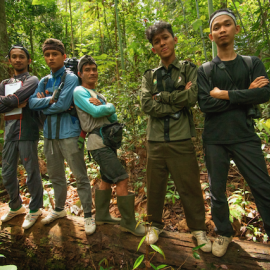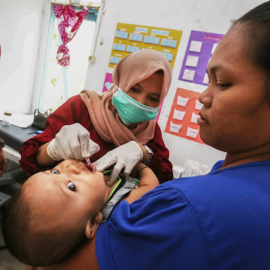Reducing Illegal Wildlife Trafficking through a Community-based Conservation Approach in West Kalimantan, Indonesia.
Current initiative
Published

One of the many SMART patrols in our Gunning Nyuit project site pauses for a quick photo while out on patrol. Credit: Running Wild Media
We built Conservation Cooperatives (CC) at two sites in West Kalimantan, Indonesia. Through this CC approach, we use a holistic strategy that integrates community-led monitoring and rule enforcement with access to community healthcare, poverty reduction initiatives through access to equitable financial capital, and livelihood development to empower communities to shift away from the illegal wildlife trade (IWT) and towards sustainable livelihood alternatives. The aim of this project is to improve wildlife densities for threatened wildlife species while improving well-being for 1,741 households and generating novel insights into community-led strategies to reduce IWT equitably.
Location
This project is based in 2 sites in West Kalimantan, Indonesia. The first is in the 180,000 ha Gunung Nyiut Penrissen Forest Complex that includes the 91,759 hectares (917 km2) Gunung Nyiut Nature Reserve (Cagar Alam Gunung Nyiut) and 60,815 hectares (608 km2) of ‘protection’ forests. The other site is located in the 229,000 ha Gunung Naning ‘protection’ forests nestled within the 2 million hectares Arabella-Schwanner landscape.
The poaching and wildlife trade problem
Species affected Sunda Bearded Pig Sus barbatus , Helmeted Hornbill Rhinoplax vigil , Straw-headed Bulbul Pycnonotus zeylanicus , Sunda Pangolin Manis javanica , Abbott’s Gibbons Hylobates abbotti , White-bearded Gibbons Hylobates albibarbis
Products in tradeProducts that enter the trade include:
1) Helmeted Hornbill - Casques
2) Sunda Pangolin - Scales, (occasionally) meat
3) Straw-headed Bulbul - live animals
4) Sunda Bearded Pig - meat
5) Abbott’s Gibbons - meat, occasionally live juveniles/offsprings
6) White-bearded Gibbons - meat, occasionally live juveniles/offsprings
7) Orangutan - meat, occasionally live juveniles/offsprings
Overview of the problem
In both sites, poachers predominantly include local villagers who are hunters. Local hunters can either be opportunistic or professional and are coaxed by non-local intermediaries (traders). Such non-local intermediaries take advantage of the poverty and lack of livelihood opportunities to entice villagers who are hunters to poach in return for certain species for relatively high sums of money for villagers.
The anti-IWT initiative
As an organization working in Borneo, Indonesia since 2014, we have gained a sound understanding of the provincial and island-wide effort to curb IWT. In particular, our conservation model is based on a holistic strategy that includes multiple programs aimed at alleviating socio-economic inequalities that are often the root cause of why rural communities become engaged in IWT activities. Our programs include establishing community-led deterrents to IWT by involving community members to monitor and enforce both national and village level (customary) rules related to forests and their wildlife. These community-led patrols use the SMART methodology and consist of one government park ranger, three/four villagers, and one Planet Indonesia field staff. During monthly patrols, SMART patrol members detect and disarm snares, record encounters of illegal activity and document wildlife.
As a regular component of each Conservation Cooperative (CC), we support the development of a village-led savings and loans program. As this program grows, it provides access to equitable financial capital that strengthens community resilience. CC members can take annual loans and receive access to a suite of financial and technical services to strengthen their livelihoods.
Our technical livelihood support utilizes a simple four-step approach, that includes:
- Identifying income-generating commodities and strategies
- Provide asset-based inputs (e.g. fertilizer, seedlings, farming equipment) to kick-start livelihoods
- Provide access to a savings/loans program to build resilience
- Provide leadership and financial literacy training to support long-term change
As part of non-financial incentives that reduce dependencies on IWT include access to basic healthcare services and information. Initial community engagements revealed that lack of access to healthcare, especially during emergencies, meant that community members needed to depend on poaching and illegal logging to pay for the high cost of accessing healthcare from distant locations. To reduce the burden of accessing healthcare, our Healthy Family program engages and trains local women as Health Ambassadors (HA). Once trained, the HAs are able to extend access and distribute basic healthcare and family planning materials in their communities. As part of this program, we also facilitate monthly visits by government health workers to provide immunizations, contraceptives, and health information to partner villages.
Inclusion of gender, age and ethnic groups
Our organizational model is built on the principles of ‘Free Prior Informed Consent' and inclusivity. Before any of our programs are implemented or our village-level partnerships are initiated, we engage in radical listening that involves understanding the specific needs of different community groups through community hearings and semi-structured Focus Group Discussions (FGDs). In each village, we conduct a minimum of 3 FGDs, 1 with only women, 1 with men and women together, and 1 with village leaders. These community hearings are open with no limit to participation, as we intend to facilitate an active discussion early on in program design.
Essentially, we recognize that the health of people and the environment are inextricably linked and that there are gender-specific needs related to healthcare and livelihood opportunities. We facilitate the participation of women in local management by encouraging collaboration, conflict resolution, compliance, and accountability through our programs. We believe that as access to equitable livelihoods, healthcare, and income-generating opportunities increase for women, they are able to benefit themselves, their families, and their surrounding ecosystems. Particularly, empowered women and girls (as well as their male counterparts) are able to move away from exploitative activities towards financially and environmentally sustainable livelihoods. Thus more than 50% of our beneficiaries are generally women.
Furthermore, we draw on the strength of women in our partner communities to support our Healthy Family Initiative (HFI) program. By recruiting and training local women to become Health Ambassadors (HAs) in their communities, we are able to create a system through which community households are able to receive access to much-needed health information and services at their doorstep. While providing information during their household visits, HAs use posters and play videos on their smartphones to make the information more enjoyable and memorable. We believe this access to information and health services increases women’s ability to exercise choice and thereby take greater control of their lives while also improving their mental and physical health leading to greater overall wellbeing.
The strategy
Strengthening disincentives for illegal behaviour
Once community members are recruited into their village SMART patrol teams, they need to spend days inside the forest during their patrols. In order to compensate for their time, they are paid a per-diem that also includes expenses related to food and refreshments. Additionally, community members are provided with uniforms and equipment that include GPS devices, cameras and data forms.
We also provide capacity-building training for community SMART patrol members to create awareness within their communities about Indonesian laws related to forests and wildlife. Similarly, these members also play a crucial part in supporting village governments in enforcing customary rules related to the use of forest products and wildlife.
Increasing incentives for wildlife stewardship
In order to reduce the incentives to engage in IWT activities, we initiate access to equitable village savings and loans programs that allow member villagers to reduce their need to depend on outside sources for access to financial capital. Other economic incentives are generated through our Sustainable Agriculture and Agroforestry programs, through which farmers receive access to organic inputs and training on its production and use, reducing farm costs.
Social incentives are created by our Healthy Family program that creates access to basic healthcare information and services for households within their villages.
In addition, through Conservation Cooperatives community members can exchange rifles to receive cash and non-cash incentives. This exchange program is supported by the local police and government management authority. Individuals are also required to sign, publically, a commitment to non-poaching upon surrendering their rifle. Incentives for the program are based on the class of the rifle (e.g. homemade vs purchased). In addition, the cash portion of the incentive is far below the value of the rifle, to avoid the scenario where individuals would use the buy-back program to access funds and upgrade.
Increasing livelihoods that are not related to wildlife
Through our Conservation Cooperative platform, we support member villagers interested in diversifying their livelihoods through technical support e.g. training on financial literacy, business development, and more.
Build/and or support sense of community ownership or stewardship
Further detailIn essence, our Conservation cooperative model begins with a commitment to the community to ensure they are actively involved in the decision-making and strategic planning of their surrounding natural resources. Once established, a CC provides the institutional framework (e.g. through monthly meetings, annual elections, etc.) to serve as a community-led management authority capable of engaging government agencies on the management of surrounding natural resources.
In the past few years, 3 of the villages we have partnered with have used our CCs to revitalize the traditional Dayak customary law (hukum adat) to prohibit excessive logging in priority zones and hunting of certain species near the reserve including the critically endangered Helmeted Hornbill. This enabled community involvement in reducing poaching and logging within and around the reserve, particularly by protecting nesting trees of Helmeted Hornbills.
Improving education and awareness
Further detailThroughout the program, multiple sessions are hosted related to poaching sanctions, protected area legislation, and national laws related to wildlife trade.
Has the initiative made a difference?
We have been supporting Dayak communities in the Gunung Nyiut site since 2016. Analysis of SMART patrol data between 2018 and 2020 from this site reveals that there has been a steep drop in incidence of hunting (by 79%), encroachment (by 86%), and logging (by 93%) within the areas patrolled inside the protected area. Additionally, SMART patrols recorded increased wildlife encounter rates (detection / km2) for several priority and endangered species such as the Helmeted Hornbill, Wreathed Hornbill, Red Langur, Mueller Gibbons, etc., with some species showing slight improvements in the surrounding forests of our working areas. This is also in line with increasing density estimates of wildlife derived using a social survey of local experts and resource collectors.
Furthermore, by the end of 2017, we noticed a 70% decrease in Global Land Analysis and Discovery (GLAD) alerts from forests around our project area. By the end of 2018, there was an additional 64% decline in GLAD alerts for forest disturbance in our project areas. Our 2-year impact evaluation showed that deforestation rates in primary rainforest dropped by 56% in the surrounding areas of our project in comparison to years prior to our program implementation. By comparing before and after results between control and impact sites, we found that over the past three years, 77% of the tree cover loss took place outside of our partnership areas. This was a clear indication for us that our holistic approach to address deforestation and biodiversity loss was succeeding in its goal.
What works and why
Removing Barriers: Our program results revealed that social and economic services are essential to removing barriers to community-led conservation. These services reduce hardships that are often limiting factors - inhibiting participation. Therefore, by focusing on barriers, and removing said barriers, we have learned our intervention style results in systems change as it addresses the underlying drivers of a defunct system versus the symptoms of biodiversity loss.
Reducing short-term costs: We have learned that social and economic services can also be essential to reducing short-term costs, or opportunity costs, of conservation initiatives. These services can help build resiliency and provide a level of socio-economic maneuverability to community partners which is essential to overcoming short-term costs of conservation initiatives.
Listening matters: In order to build trust and create positive relationships, we have learned that listening and remaining adaptive to new opportunities and challenges that communities face is extremely important. For example, we pivoted in 2020 to provide additional covid-19 support for community partners, leveraging our health teams to improve surveillance, and even administering a large conditional cash transfer to families impacted by the pandemic.
Trust and Relationships Matter: Most of our success has been underpinned by creating trust with local community partners. We saw, in certain areas, where the presence of poaching risked program compliance factors that community members pressured non-participants to stop poaching and join the program to ensure that program services continued. Social and economic services were identified through impact assessments as not only addressing barriers and reducing the opportunity costs of conservation, but also created a “good will effect” where community partners believed and trusted the organization. Read more about lessons learned related to relationships and trust here.
Factors for success
Devolved decision-making power so local communities have a voice in creating or co-creating solutions (as part of the initiative)
Effective and trusted community leaders
Transparent and accountable distribution of benefits to local communities
What doesn’t work and why
The major challenges related to the program came from a lack of clarity on tenure. The Gunung Nyiut and Naning protected areas were customary forests that were turned into state-led protected areas in the 1980s. Many community members discussed that because there was no longer any local ownership, that they viewed it in their best interest to exploit the landscape before the government sold it to a private sector company or further limited their use of the area. This was a major limiting factor for villages located inside the protected area, that in accordance with the law, denies them the ability to access a variety of basic government services.
Factors that limited or hindered success
Lack of supportive, multi-stakeholder partnerships with a shared vision
Lack of clearly defined tenure or resource use rights
Organisers, donors and partners
The IWT Challenge Fund - UKAID
For further information contact Josephine Crouch (josephine@planetindonesia.org).


